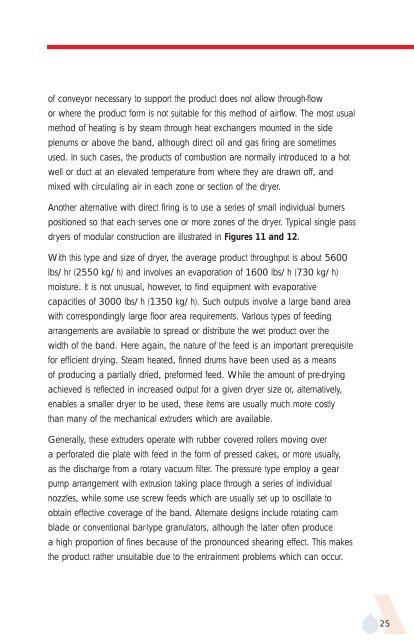APV Dryer Handbook - Umbc
APV Dryer Handbook - Umbc
APV Dryer Handbook - Umbc
You also want an ePaper? Increase the reach of your titles
YUMPU automatically turns print PDFs into web optimized ePapers that Google loves.
of conveyor necessary to support the product does not allow through-flow<br />
or where the product form is not suitable for this method of airflow. The most usual<br />
method of heating is by steam through heat exchangers mounted in the side<br />
plenums or above the band, although direct oil and gas firing are sometimes<br />
used. In such cases, the products of combustion are normally introduced to a hot<br />
well or duct at an elevated temperature from where they are drawn off, and<br />
mixed with circulating air in each zone or section of the dryer.<br />
Another alternative with direct firing is to use a series of small individual burners<br />
positioned so that each serves one or more zones of the dryer. Typical single pass<br />
dryers of modular construction are illustrated in Figures 11 and 12.<br />
With this type and size of dryer, the average product throughput is about 5600<br />
lbs/hr (2550 kg/h) and involves an evaporation of 1600 lbs/h (730 kg/h)<br />
moisture. It is not unusual, however, to find equipment with evaporative<br />
capacities of 3000 lbs/h (1350 kg/h). Such outputs involve a large band area<br />
with correspondingly large floor area requirements. Various types of feeding<br />
arrangements are available to spread or distribute the wet product over the<br />
width of the band. Here again, the nature of the feed is an important prerequisite<br />
for efficient drying. Steam heated, finned drums have been used as a means<br />
of producing a partially dried, preformed feed. While the amount of pre-drying<br />
achieved is reflected in increased output for a given dryer size or, alternatively,<br />
enables a smaller dryer to be used, these items are usually much more costly<br />
than many of the mechanical extruders which are available.<br />
Generally, these extruders operate with rubber covered rollers moving over<br />
a perforated die plate with feed in the form of pressed cakes, or more usually,<br />
as the discharge from a rotary vacuum filter. The pressure type employ a gear<br />
pump arrangement with extrusion taking place through a series of individual<br />
nozzles, while some use screw feeds which are usually set up to oscillate to<br />
obtain effective coverage of the band. Alternate designs include rotating cam<br />
blade or conventional bar-type granulators, although the latter often produce<br />
a high proportion of fines because of the pronounced shearing effect. This makes<br />
the product rather unsuitable due to the entrainment problems which can occur.<br />
25











